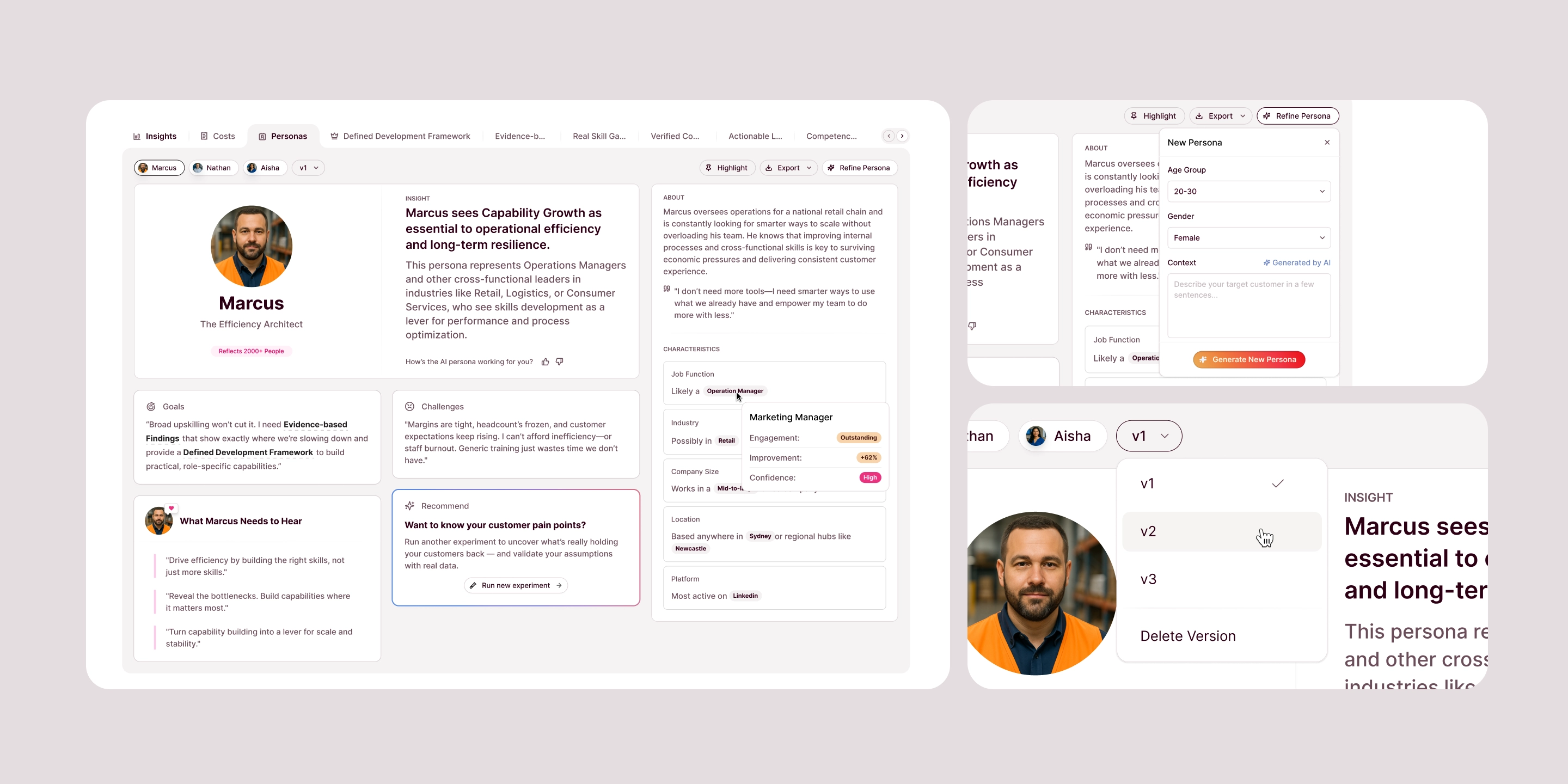
Heatseeker is an AI-powered SaaS platform that enables rapid market experimentation through live tests on social media. It helps businesses uncover what truly resonates with their audience, optimise messaging, and confidently invest in high-potential ideas. By leveraging real-time customer insights, Heatseeker turns gut instincts into data-validated strategies, accelerating growth and reducing time-to-market.
Brought on as a contractor, I was responsible for kickstarting the design of the AI Persona feature—leading the full UX process from research and ideation to prototyping and developer hand-off. I collaborated closely with the product team to define user goals and pain points, mapped key user flows, and designed wireframes and high-fidelity prototypes.
I delivered an MVP that laid a solid foundation for the design team, enabling them to further evolve the feature based on user needs. This helped the team move forward with clarity and direction, ensuring the product delivers actionable, data-driven insights to its users.
Due to company policy, much of my work on this project remains confidential. Feel free to reach out if you’d like to learn more.

Throughout my career as a product designer, I’ve collaborated closely with marketers and business owners, and I’ve seen firsthand the constraints they face, limited time, budget, and access to real data, when making strategic decisions. Personas are commonly used to align marketing efforts with customer needs and help teams across product lines better understand their audience. In early discovery interviews, users expressed frustration with the manual persona creation process, describing it as time-consuming, subjective, and often disconnected from real customer behaviour. Without data-backed personas, teams risk misaligned strategies and missed opportunities, underscoring the need for a faster, more reliable, and actionable solution.
No matter how many times I start a design process, I always begin with research. It helps me understand the problem space, uncover opportunities, and gain the context needed to inform effective design decisions. For this project, I studied established persona frameworks to learn how marketers traditionally build personas. I also conducted competitor analysis to identify what existing tools do well and where they fall short, helping me define clear opportunities and position our product more strategically.

This tool requires users to manually define each persona, which can be time-consuming. However, its export feature is well-designed, making it easy to share the persona documents with team members for collaboration.
It uses AI to generate personas based on provided context; however, the resulting profiles often feel artificial, raising concerns about their accuracy. This makes it difficult for users to confidently rely on the personas for decision-making.
Another AI-powered persona generator, but the key question remains: how accurate is it? Without supporting data, users may doubt whether the generated personas truly represent their target audience, risking misguided decisions.
I collaborated with the CPO and consulted clients to gather requirements for the persona feature. This informed which data and AI modules to use and what information would be most valuable. Throughout the process, I began developing a mindset that I believe every designer should embrace: asking questions and seeking clarity whenever possible. Doing so ensures we truly consider users' needs at every stage of the design process.
“Good design starts with good questions. Curiosity is how we uncover real user needs and design with intention.”
Together, we developed a solution and created a standardised prompt for the LLM to generate persona outputs, providing marketers with an intuitive, data-backed way to build accurate personas that enhance audience targeting and drive conversions.
Before diving into visual design, I always start with sketching and wireframing. This step is crucial for organizing my thoughts and exploring different ways to present information effectively.
For the AI persona feature, the key design challenge was maintaining simplicity. Since all information is data-driven, it was important to avoid overwhelming users with complex visuals. Each time I created wireframes, I focused on clearly structuring the LLM-generated outputs in the UI. I then gathered feedback from the team iteratively to ensure the design was informed by real input, not assumptions.
I prototyped 8 iterations to validate assumptions around persona navigation, data display, and how users read and interpret the content. I learned that prototyping is not just about gathering feedback or testing the product; it’s about clearly defining what information you want from users, how you plan to collect it, and which aspects of the design you aim to evaluate. Without a clear strategy, prototyping can become aimless and inefficient. Working in a startup environment allowed me to continuously apply this strategic mindset, iterating designs multiple times based on solid user feedback to refine and improve the product.

This feature is still actively evolving. The MVP I designed has successfully attracted interest from clients like Medibank, HCF, and ADMA, who see strong potential in the tool. During client pitches, the AI-generated language in the personas resonated strongly, prompting several “aha” moments. Following these sessions, we gathered valuable feedback, which I analysed to identify future design directions and uncover new opportunities. These insights will guide the next iteration phase, with a focus on improving usability, refining data presentation, and expanding functionality to better support marketing teams.

Client feedback revealed that different product lines often created separate, unaligned personas due to siloed marketing experiments. Without real audience data, these personas were largely assumption-based, making them unreliable and inconsistent. This prevented teams from identifying behavioural patterns or communication tone, ultimately hindering their ability to craft targeted, effective messaging.
To create a unified, data-driven persona system that helps teams generate consistent, accurate, and actionable customer profiles across product lines, enabling more aligned marketing strategies, clearer audience understanding, and more effective, targeted messaging.
Generate actionable insights into customers’ backgrounds, needs, and behaviours to support strategic decision-making.
Link live data points to persona attributes, increasing credibility and confidence in the output.
Enable cross-team collaboration by providing a unified persona format accessible to multiple product lines.
Support deeper exploration of customer motivations and pain points to uncover opportunities for alignment and growth.
This feature is still actively evolving. Based on additional feedback collected from users, I’ve analysed the data to identify future design directions and uncover new opportunities for improvement. These insights will inform the next phase of iteration, focusing on enhancing usability, refining data presentation, and expanding functionality to better support marketing teams.

Working on this project helped me uncover a deeper challenge in designing AI-powered experiences: while AI can automate and accelerate tasks like persona generation, it often lacks the nuance, emotion, and context that create a genuine human connection. I realised that bridging the gap between AI output and real user experience isn't just about functionality — it's about trust, relatability, and relevance. Many users shared that the personas felt too generic, making it hard to see their real customers reflected in the results. This experience taught me that to design more human AI experiences, we need to go beyond the output by embedding real data to build credibility, allowing interaction to foster engagement, and enabling personalisation to reflect unique user contexts. Designing with these principles brings AI closer to people, not just in utility, but in empathy.